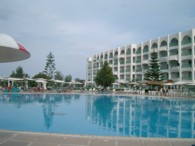THESSALONIKI |
|
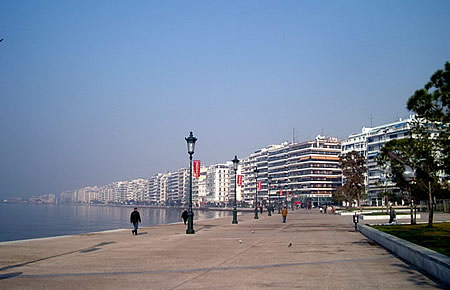
 
| THESSALONIKI THROUGH SYMBOLS |
|
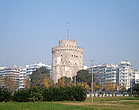
|
The White Tower is for many people the most important symbol of Thessaloniki. It was built in 1530 by the Turkish Sultan Suleiman the Magnificent, in order to guard the eastern town fortress walls. At present, there is the Museum of Byzantine Culture, selected in 2005 for the best one in Europe. Near it, there is the outstanding Archaeological Museum of Thessaloniki, having a great collection of valuable exhibits, including a precious value, such as the Artifact of Philip the
|
|
Macedon (discovered in Vergina, in 1977). |
|
The Arch of Galerius, colloquially known as the Kamara, is, beside the White Tower, one of the best known Thessaloniki sights. Located in the Egnatia Street, just in the center of the city, it was built to the honor of the Roman Emperor Galerius, on the occasion of his triumphal return to the Thessaloniki after defeating the Persians. Ano Poli or the Upper Town is the remnant of the Ottoman Thessaloniki. It is on the UNESCO Cultural Heritage List and under the Government's protection as a memory of the city's traditional look. |
|
|
Agios Dimitrios Church is the most important church in Thessaloniki. Located above the remnants of Agora and the Roman Forum, it has got the chapel, museum and underground catacombs, including the prison cell of the Saint Demetrius, patron saint of the city. Although it suffered many destructions and restoring during centuries, the Agios Dimitrios Church kept the authentic style and spirit of its time architecture.
There is a reliquary preserved in it - the relicts of this magic Saint, who was born in Thessaloniki and died in Sirmium, Serbia, the present Sremska Mitrovica. From the Agiou Dimitrios Church, the road descends to the Dicastrion Square, dominated by Elefterios Venizelos in the form of the stone statue.
  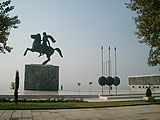
|
|
|
|
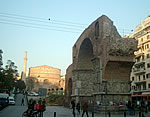

|
|
For getting to know Thessaloniki, inevitable is the impressive Saint George Rotunda, built around 400 BC, decorated by some of the most beautiful mosaics of the Early Christianity. In Thessaloniki itself, there are several churches among the most beautiful ones in the Byzantine world: Agia Sophia, Agioi Apostoloi, The Prophet Elijah Church, Saint Panteleimon and others. Complicated relations of Greece and Turkey resulted in the fact that from the time of many centuries long Turkish reign in Thessaloniki, the only visible points are a mosque, several hammams and bazaars in a very bad condition, as well as the birth place of the modern Turkey creator - Kemal Atatürk.
|
|
|
|
|
|
AMBITIOUS
Thessaloniki (Thessalonica) is one of the oldest European cities, the second largest in Greece and the capital of the largest national region - Central Macedonia. After Athens, it is the largest, the most vibrant, the most unusual, the most exciting and the most ambitious city in Greece that keeps the pace with the global metropolises and in 1997, it was declared the European Capital of Culture. For many tourists, Thessaloniki is a destination offering tourism luxury and complete offer, from high quality museums, concerts and events, good shopping, through the various patterns of its far away famous green market and diverse food, to the plentiful night life, especially in the summer period.

Thessaloniki, situated between the Thermaic Gulf and Mount Chortiatis, near the mouth of the Gallikos and Axios rivers, it is full of cultural/historical monuments, excellent museums, beautiful buildings, comfortable hotels and many restaurants. It is very easy to get to know it through diverse scents, tastes, sounds, architecture, light, people. Thessaloniki is a comfortable city for tourists , those who experience it from the Byzantine walls surrounding it or those walking through the narrow network of streets, squares, balconies, churches, ruins, descending, staggering to the promenade by the sea to the harbor.
 
The history of Thessaloniki is a rough as the sea splashing it. Various nations passed through it and left their traces and habits. The city itself was founded around 315 BC. It was founded by the King Cassander of Macedon and called it after his loving wife Thessalonike,daughter of Philip the Macedon and half-sister of Alexander the Great. In time it developed into an important trading center on the Via Egnatia route, connecting Europe and Asia.
For the Serbs, Thessaloniki is especially important also as the memory place to the most glorious pages of the national history.
Zeitenlik, Allied Memorial Military Cemetery of the First World War, where more than two thousand Serbian soldiers were buried, is very well visited and touching notes and gifts show the relation to the far past is alive and stratified.
|
|
At present, Thessaloniki is also a University City, advanced port, industrial and economic destination with the famous EXPO Center dominated by the OTE Tower, one of the city symbols, the cultural center proud of the most important Film Festival in the region, Art Biennale and the Summer Festival. Thessaloniki is a city in the continuous move, in which there is the famous shopping Egnatia Street, not only the largest and longest one, but also a part of the ancient Roman Via Egnatia road that connected Constantinople and the Dyrrhachium harbor. As regarding the shopping, Ernou and Tsimiski should never be omitted. There is something both to see and buy. A special story is the picturesque green market, one of the best known ones in Europe, with diverse offer of spices, fresh and candied fruits, fish, meat and various goods. In the evening hours, it turns into the Bohemian inns district with the authentic Greek music, food, such as 'Bear's Foot', 'Lamb Chops', 'Souvlaki' or 'Gyros', followed by 'Retsina' wine.
The tourist experience of Thessaloniki is fully in accordance with the slogan of this city's Tourism Organization - 'Many Stories - One Heart'. It makes you completely happy and in every sense of the word, wherever you may come from, Thessaloniki is so close. |
|

